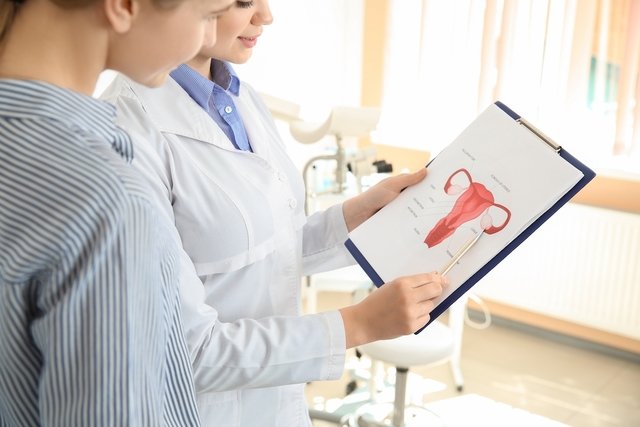Polycystic ovary syndrome is a hormonal disorder characterized by the formation of cysts in the ovaries, increased testosterone and lack of ovulation, causing symptoms such as irregular menstruation, hair loss, appearance of hair on the face or difficulty getting pregnant.
The exact cause of polycystic ovary syndrome (PCOS) is not yet fully known, but it appears to be related to a combination of genetic and environmental factors, such as obesity or insulin resistance, and is more common in early adolescence.
The treatment of polycystic ovary syndrome is carried out by a gynecologist, who can recommend the most appropriate treatment, which usually involves the use of medicines that help alleviate symptoms and regulate hormonal levels.

Polycystic ovary symptoms
The main symptoms of polycystic ovary are:
- Irregular menstruation or absence of menstruation;
- Hair loss;
- Difficulty getting pregnant;
- Appearance of hair on the face and body;
- Increased skin oiliness;
- Greater chance of developing acne;
- Unintentional weight gain;
- Delay in breast development.
The symptoms of polycystic ovary can vary from woman to woman and according to hormonal changes, and may be more or less intense, or sometimes not present any symptoms at all, other than irregular menstruation. See other symptoms of polycystic ovary.
If a woman identifies the appearance of at least two of the symptoms, it is important to consult a gynecologist so that an evaluation can be carried out and tests can be requested to investigate the possibility of ovarian cysts.
Do the symptoms continue even after menopause?
It is possible that the symptoms of polycystic ovary persist even after menopause, as during this period there is a decrease in female hormones, so that the symptoms can be noticed more easily.
After menopause, it is common to notice weakening of the hair, hair loss and hair growth on other parts of the body, such as the face and chest.
Furthermore, the risk of problems such as heart attack, stroke and diabetes also increases after menopause. Know how to identify the symptoms of menopause.
How to confirm the diagnosis
The diagnosis of polycystic ovary is made by the gynecologist through evaluation of symptoms, pelvic examination and results of imaging and laboratory tests.
If you have symptoms of polycystic ovary syndrome, schedule an appointment with a gynecologist in the nearest region:
Taking care of your health has never been easier!
Tests for polycystic ovary
The main tests for polycystic ovaries are:
- Pelvic or transvaginal ultrasound;
- Progesterone levels in the luteal phase, on days 20 to 21 of the menstrual cycle;
- Measurement of free and total testosterone, androstenedione and dehydroepiandrosterone (DHEA);
- LH, FSH and prolactin hormones;
- Thyroid hormones, such as T3, T4 and TSH;
- Anti-Mullerian hormone, in some cases.
Another test that your doctor may order is a fasting blood glucose test and a glucose tolerance test, to assess the presence of diabetes or insulin resistance. Find out how the glucose tolerance test is performed.
Can people with polycystic ovaries get pregnant?
Pregnancy with PCOS is possible, as long as the treatment is being carried out correctly according to the gynecologist’s instructions. In general, women with polycystic ovaries respond well to treatment with medications that induce ovulation, such as clomiphene.
Furthermore, although menstruation is irregular, within a few months a woman can ovulate spontaneously, becoming pregnant without medical help. Understand better if it is possible to get pregnant with polycystic ovaries.
However, it is advisable to see a gynecologist to increase the chances of pregnancy, especially after 1 year of unsuccessful attempts to get pregnant.
Possible causes
Polycystic ovary syndrome does not have a well-defined cause, however, it is believed that it may occur due to a combination of genetic and environmental factors.
The main factors that can increase the risk of polycystic ovaries are:
- Genetic predisposition;
- Obesity or overweight;
- Insulin resistance;
- Pre-diabetes;
- Increase in androgenic hormones, mainly testosterone.
Furthermore, other factors are inadequate nutrition and lack of physical activity.
How the treatment is carried out
Treatment for polycystic ovary syndrome must be carried out according to the gynecologist’s guidance, and aims to regulate hormonal levels, menstruation and improve fertility.
The main treatments for polycystic ovary are:
1. Lifestyle changes
Lifestyle changes involving eating a balanced, healthy and varied diet, low in fat and sugar, and exercising regularly can help reduce insulin resistance and improve the effectiveness of PCOS medications.
These changes in lifestyle can promote weight loss, and in the case of women who are overweight or obese, a diet guided by a nutritionist and follow-up with an endocrinologist should be followed, who can indicate the best treatment for weight loss. Weight. See how obesity is treated.
Check out the video below for some nutrition tips for polycystic ovaries:
2. Remedies for polycystic ovaries
The main remedies for polycystic ovary are:
- Combined or progesterone-only contraceptive pills, to regulate hormones and the menstrual cycle;
- Diuretics, such as spironolactone, as it reduces testosterone levels in the body and hair growth;
- Medicines to treat infertility, such as clomiphene, letrozole or gonadotropins;
- Antidiabetics, such as metformin, to improve insulin resistance or treat type 2 diabetes.
Furthermore, if a woman has a lot of acne, acne treatment with ointments, creams or gels may be recommended, preferably with the guidance of a dermatologist. Check out the main acne remedies.
Read too: 10 home remedies for polycystic ovary (and how to prepare)
3. Surgery
In more serious cases, when there are a large number of cysts, increasing the size of the ovary, surgery may be recommended to remove the cysts or ovary. See more details on the treatment for polycystic ovary.

Sign up for our newsletter and stay up to date with exclusive news
that can transform your routine!
Warning: Undefined array key "title" in /home/storelat/public_html/wp-content/plugins/link-whisper-premium/templates/frontend/related-posts.php on line 12
Warning: Undefined array key "title_tag" in /home/storelat/public_html/wp-content/plugins/link-whisper-premium/templates/frontend/related-posts.php on line 13



